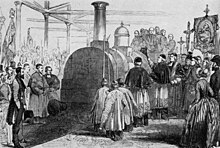
George Stephenson was an English civil engineer and mechanical engineer during the Industrial Revolution. Renowned as the "Father of Railways", Stephenson was considered by the Victorians as a great example of diligent application and thirst for improvement. His chosen rail gauge, sometimes called "Stephenson gauge", was the basis for the 4-foot-8+1⁄2-inch (1.435 m) standard gauge used by most of the world's railways.

Stephenson's Rocket is an early steam locomotive of 0-2-2 wheel arrangement. It was built for and won the Rainhill Trials of the Liverpool and Manchester Railway (L&MR), held in October 1829 to show that improved locomotives would be more efficient than stationary steam engines.

The Liverpool and Manchester Railway (L&MR) was the first inter-city railway in the world. It opened on 15 September 1830 between the Lancashire towns of Liverpool and Manchester in England. It was also the first railway to rely exclusively on locomotives driven by steam power, with no horse-drawn traffic permitted at any time; the first to be entirely double track throughout its length; the first to have a true signalling system; the first to be fully timetabled; and the first to carry mail.
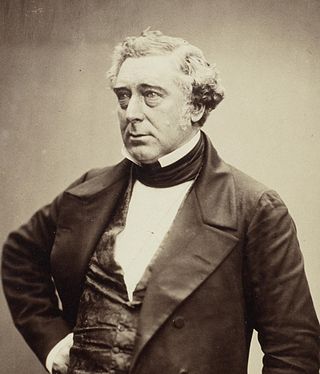
Robert Stephenson FRS HFRSE FRSA DCL was an English civil engineer and designer of locomotives. The only son of George Stephenson, the "Father of Railways", he built on the achievements of his father. Robert has been called the greatest engineer of the 19th century.
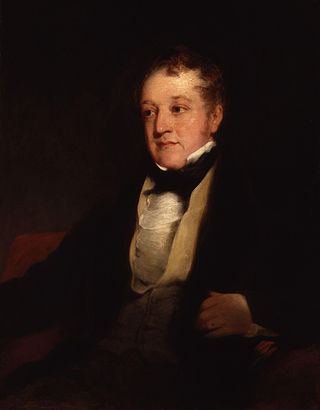
William Huskisson was a British statesman, financier, and Member of Parliament for several constituencies, including Liverpool.

Joseph Locke FRSA was a notable English civil engineer of the nineteenth century, particularly associated with railway projects. Locke ranked alongside Robert Stephenson and Isambard Kingdom Brunel as one of the major pioneers of railway development.

Sir John Fowler, 1st Baronet, KCMG, LLD, FRSE was an English civil engineer specialising in the construction of railways and railway infrastructure. In the 1850s and 1860s, he was engineer for the world's first underground railway, London's Metropolitan Railway, built by the "cut-and-cover" method under city streets. In the 1880s, he was chief engineer for the Forth Bridge, which opened in 1890. Fowler's was a long and eminent career, spanning most of the 19th century's railway expansion, and he was engineer, adviser or consultant to many British and foreign railway companies and governments. He was the youngest president of the Institution of Civil Engineers, between 1865 and 1867, and his major works represent a lasting legacy of Victorian engineering.

Thomas Brassey was an English civil engineering contractor and manufacturer of building materials who was responsible for building much of the world's railways in the 19th century. By 1847, he had built about one-third of the railways in Britain, and by time of his death in 1870 he had built one in every twenty miles of railway in the world. This included three-quarters of the lines in France, major lines in many other European countries and in Canada, Australia, South America and India. He also built the structures associated with those railways, including docks, bridges, viaducts, stations, tunnels and drainage works.

Ruston & Hornsby was an industrial equipment manufacturer in Lincoln, England founded in 1918. The company is best known as a manufacturer of narrow and standard gauge diesel locomotives and also of steam shovels. Other products included cars, steam locomotives and a range of internal combustion engines, and later gas turbines. It is now a subsidiary of Siemens.

The Liverpool and Manchester Railway (LMR) 57 Lion is an early 0-4-2 steam locomotive, which had a top speed of 40 mph (64 km/h) and could pull up to 200 tons. One of a pair designed for hauling freight, Lion was built by Todd, Kitson & Laird of Leeds in 1838. It featured in the 1953 Ealing comedy, The Titfield Thunderbolt.

Henry Booth was a British corn merchant, businessman and engineer particularly known as one of the key people behind the construction and management of the pioneering Liverpool and Manchester Railway (L&M), the world's first steam railway conducting both scheduled passenger services and freight.
The Compagnie des chemins de fer de l'Ouest, often referred to simply as L'Ouest or Ouest, was an early French railway company which operated from the years 1855 through 1909.
Edge Hill railway works was built by the Liverpool and Manchester Railway around 1830 at Edge Hill, Liverpool. A second was built in 1839 by the Grand Junction Railway adjacent to it.
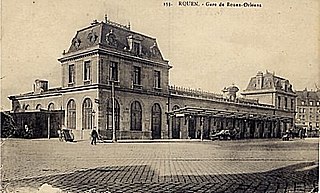
The Compagnie du Chemin de Fer d'Orléans à Rouen was a French railway company. The company was created in 1872 by M. Ridder, and subsequently absorbed by the Chemins de fer de l'Ouest in 1891.

Union Sportive Quevillaise-Rouen Métropole, known as US Quevilly-Rouen, US Quevilly, QRM, Quevilly-Rouen, or simply Quevilly, is a football club based in Le Petit-Quevilly in the Métropole Rouen Normandie, France. The club plays in Ligue 2 and hosts its home matches at the Stade Robert Diochon, which has a capacity of 8,372.

Henry Robertson was a Scottish mining engineer and prolific railway builder, industrialist and Liberal Party politician. He was head of Brymbo Steelworks, Wrexham. He was co-founder of Beyer-Peacock, with Charles Beyer, and Richard Peacock. His son Sir Henry Beyer Robertson was knighted by Queen Victoria for the achievements of his father.
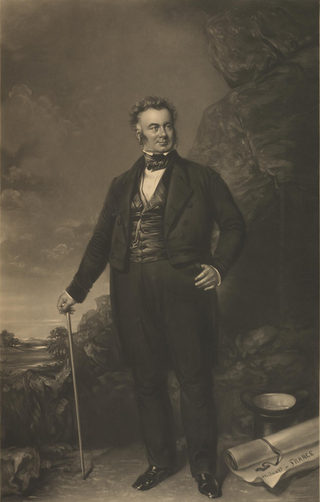
William Mackenzie was an Anglo-Scottish civil engineer and civil engineering contractor who was one of the leading European contractors in the 1840s.

A skew arch is a method of construction that enables an arch bridge to span an obstacle at some angle other than a right angle. This results in the faces of the arch not being perpendicular to its abutments and its plan view being a parallelogram, rather than the rectangle that is the plan view of a regular, or "square" arch.
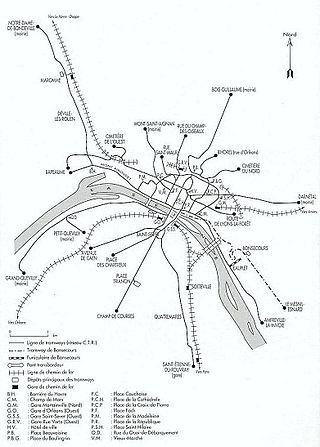
There have been two separate generations of trams in Rouen. The first generation tramway was a tram network built in Rouen, Normandy, northern France, that started service in 1877, and finally closed in 1953. There were no trams at all in Rouen between 1953 and 1994, when the modern Rouen tramway opened.

Sir Edward Charles Blount was an English banker in Paris and promoter of French railways.



